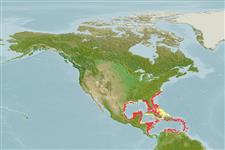>
Gobiiformes (Gobies) >
Gobiidae (Gobies) > Gobiinae
Etymology: Microgobius: Greek, mikros = small + Latin, gobius = gudgeon (Ref. 45335).
More on author: Fowler.
Environment: milieu / climate zone / depth range / distribution range
Ecología
marino asociado a arrecife; rango de profundidad 0 - 36 m (Ref. 92840). Subtropical; 37°N - 10°N
Western Atlantic: North Carolina, USA and eastern Gulf of Mexico to the Lesser Antilles.
Tamaño / Peso / Age
Maturity: Lm ? range ? - ? cm
Max length : 10.0 cm SL macho / no sexado; (Ref. 92840)
Distinguished by the following characteristics: general body color is light grey-brown, typically have areas of very bright iridescent blue and/or yellow; body is laterally compressed; large, nearly vertical mouth; completely scaled body; first dorsal with VII spines; ventral fins are united (Ref. 92840).
Burrows in bottom in open stretches of coarse sand. Often hovers over burrow. Also known to inhabit mangrove streams with very fine silt-mud substrate (Ref. 92840).
Life cycle and mating behavior
Madurez | Reproducción | Puesta | Huevos | Fecundidad | Larva
Robins, C.R. and G.C. Ray, 1986. A field guide to Atlantic coast fishes of North America. Houghton Mifflin Company, Boston, U.S.A. 354 p. (Ref. 7251)
IUCN Red List Status (Ref. 130435)
Threat to humans
Harmless
Human uses
Acuario: Comercial
Más información
ReferenciasAcuiculturaPerfil de acuiculturaRazasGenéticaElectrophoresesheritabilidadEnfermedadesProcesamientoNutrientsMass conversion
Herramientas
Special reports
Download XML
Fuentes de Internet
Estimates based on models
Preferred temperature (Ref.
123201): 23.7 - 28.1, mean 27.2 °C (based on 445 cells).
Phylogenetic diversity index (Ref.
82804): PD
50 = 0.5000 [Uniqueness, from 0.5 = low to 2.0 = high].
Bayesian length-weight: a=0.00708 (0.00333 - 0.01504), b=3.09 (2.92 - 3.26), in cm total length, based on LWR estimates for this (Sub)family-body shape (Ref.
93245).
Nivel trófico (Ref.
69278): 3.4 ±0.4 se; based on size and trophs of closest relatives
Resiliencia (Ref.
120179): Alto, población duplicada en un tiempo mínimo inferior a 15 meses (Preliminary K or Fecundity.).
Fishing Vulnerability (Ref.
59153): Low vulnerability (10 of 100).
Nutrients (Ref.
124155): Calcium = 83.6 [33.3, 182.1] mg/100g; Iron = 0.747 [0.330, 1.528] mg/100g; Protein = 18.6 [16.6, 20.4] %; Omega3 = 0.144 [0.058, 0.300] g/100g; Selenium = 11.9 [4.8, 29.9] μg/100g; VitaminA = 80.7 [18.5, 321.2] μg/100g; Zinc = 1.33 [0.78, 2.22] mg/100g (wet weight);
